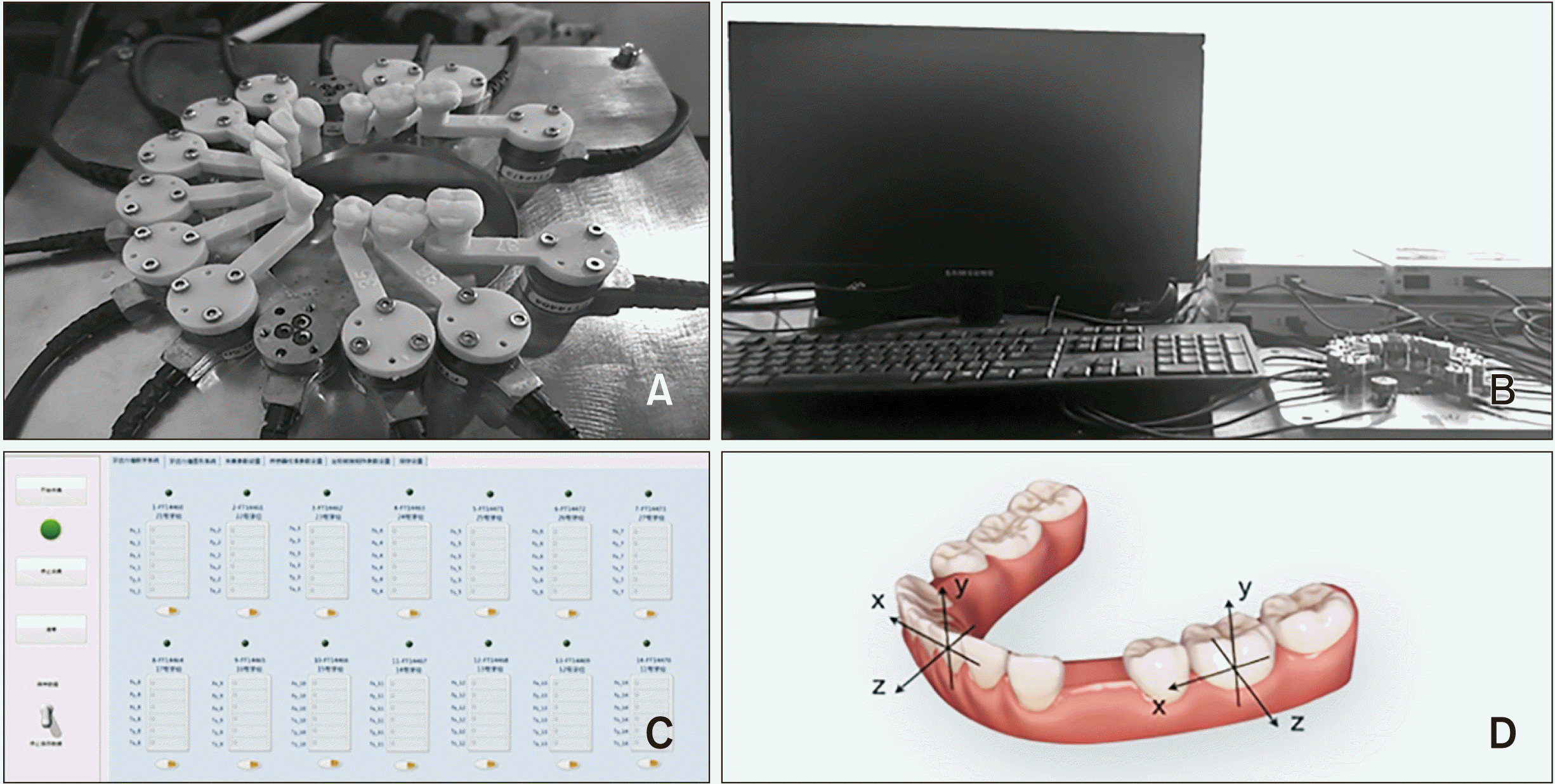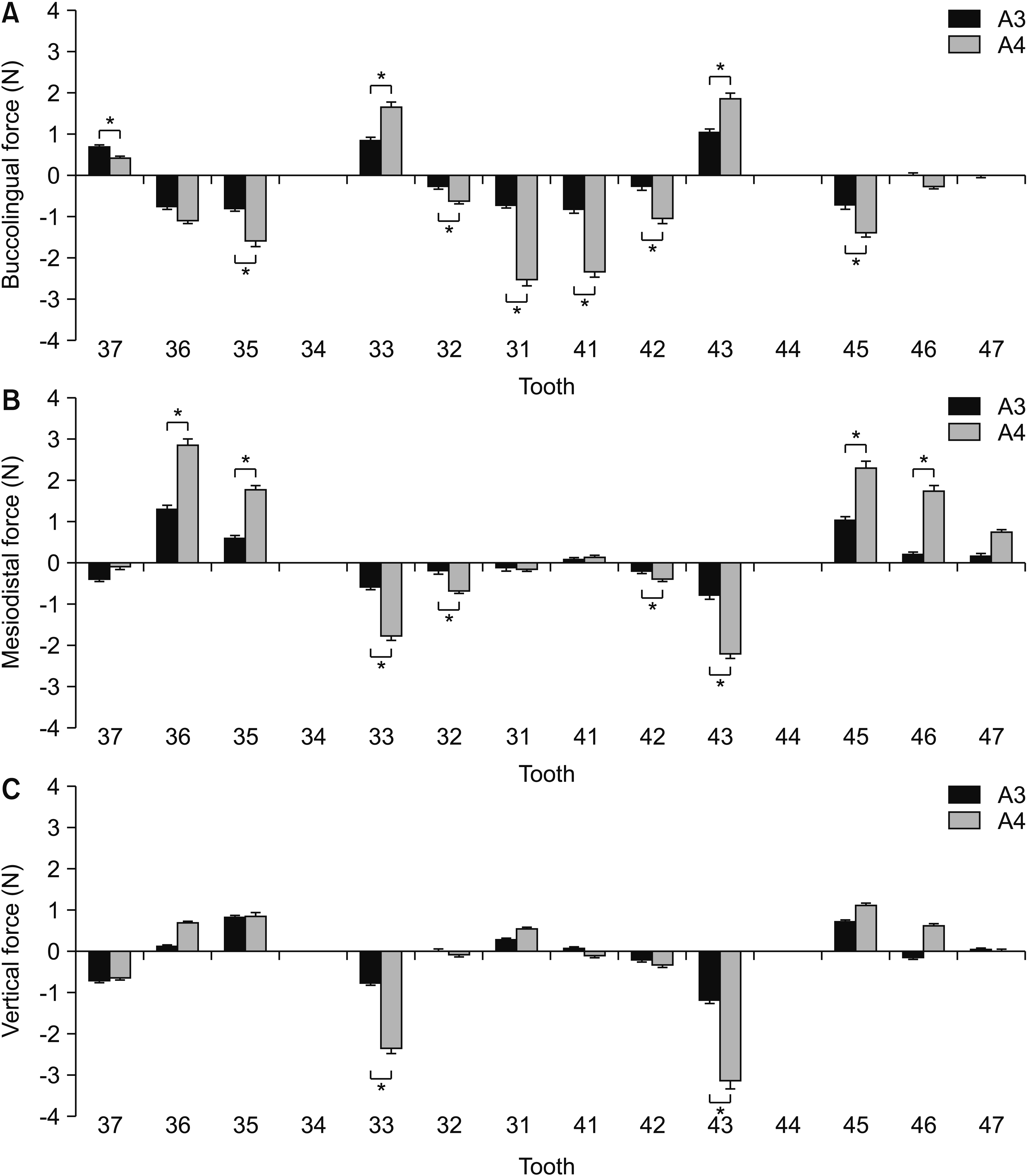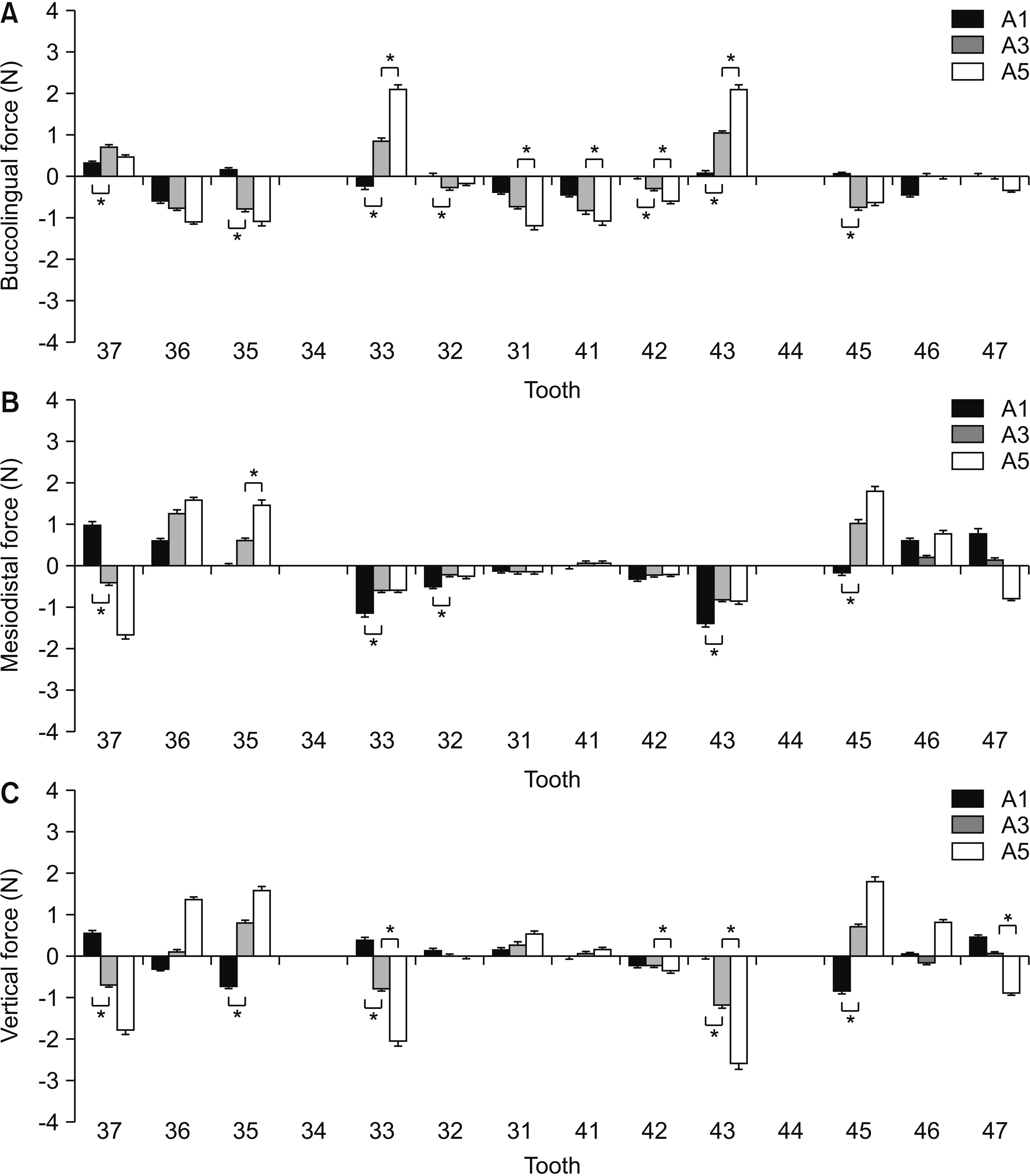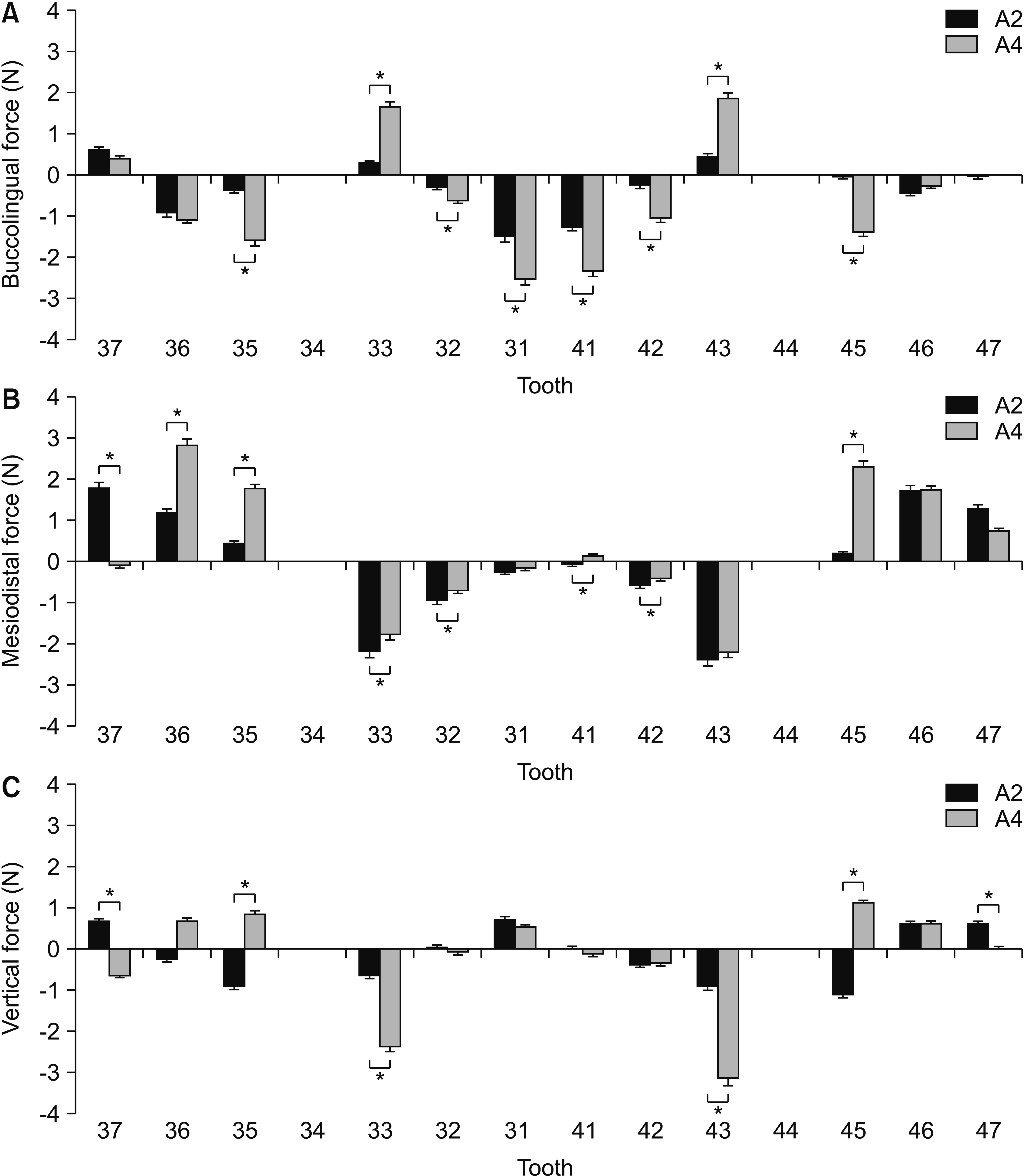INTRODUCTION
MATERIALS AND METHODS
Study protocol
Table 1
| Group |
Amount of retraction (mm) |
Amount of intrusion (mm) |
|---|---|---|
| A0 | 0 | 0 |
| A1 | 0.25 | 0 |
| A2 | 0.5 | 0 |
| A3 | 0.25 | 0.25 |
| A4 | 0.5 | 0.5 |
| A5 | 0.25 | 0.5 |
Group A0, control group with no activation; Group A1, underwent 0.25-mm retraction; Group A2, underwent 0.50-mm retraction; Group A3, underwent 0.25-mm retraction and 0.25-mm intrusion; Group A4, underwent 0.50-mm retraction and 0.50-mm intrusion; Group A5, underwent 0.25-mm retraction and 0.5-mm intrusion.
Aligner fabrication and test apparatus construction
 | Figure 1The force measurement system. A, Three-dimensional-printed resin teeth connected separately with the multi-axis force/moment transducer by hexagonal screws. B, The computer linked with the measurement system. C, The real-time visualization window of Angelalign Mechanical Measurement Software (Wuxi Angel Align Biotechnology Co., Ltd., Wuxi, China). D, The coordinate system for the forces and moments measured. The y-axis runs through the center of tooth and parallel to the long axis of this tooth. The x-axis is oriented parallel to the mesiodistal direction of teeth. The z-axis represents the labiolingual/buccolingual force. |
Data collection
 | Figure 2Comparisons of the three-dimensional forces in groups A1 and A2. A, Forces in the buccolingual direction. B, Forces in the mesiodistal direction. C, Forces in the vertical direction.
Group A1, underwent 0.25-mm retraction; Group A2, underwent 0.50-mm retraction.
*p < 0.05.
|
 | Figure 3Comparisons of the three-dimensional forces in groups A3 and A4. A, Forces in the buccolingual direction. B, Forces in the mesiodistal direction. C, Forces in the vertical direction.
Group A3, underwent 0.25-mm retraction and 0.25-mm intrusion; Group A4, underwent 0.50-mm retraction and 0.50-mm intrusion.
*p < 0.05.
|
 | Figure 4Comparisons of the three-dimensional forces in groups A1, A3, and A5. A, Forces in the buccolingual direction. B, Forces in the mesiodistal direction. C, Forces in the vertical direction.
Group A1, underwent 0.25-mm retraction; Group A3, underwent 0.25-mm retraction and 0.25-mm intrusion; Group A5, underwent 0.25-mm retraction and 0.5-mm intrusion.
*p < 0.05.
|
 | Figure 5Comparisons of three-dimensional forces in groups A2 and A4. A, Forces in the buccolingual direction. B, Forces in the mesiodistal direction. C, Forces in the vertical direction.
Group A2, underwent 0.50-mm retraction; Group A4, underwent 0.50-mm retraction and 0.50-mm intrusion.
*p < 0.05.
|
Table 2
| Tooth number | Force direction | A0 | A1 | A2 | A3 | A4 | A5 |
|---|---|---|---|---|---|---|---|
| 37 | Fx¶ | 0.26 ± 0.35 | 1.00 ± 1.58‡‖ | 1.82 ± 0.54‡§‖ | −0.43 ± 0.71*† | −0.13 ± 0.92†‖ | −1.68 ± 0.96*†§ |
| Fy¶ | 1.37 ± 0.27 | 0.58 ± 0.98‡§‖ | 0.70 ± 0.81‡§‖ | −0.74 ± 0.44*† | −0.67 ± 1.10*†‖ | −1.80 ± 0.73*†§ | |
| Fz** | −0.94 ± 0.12 | 0.34 ± 0.17‡ | 0.65 ± 0.25 | 0.71 ± 0.18*§ | 0.44 ± 0.15‡ | 0.49 ± 0.24 | |
| 36 | Fx¶ | −1.11 ± 0.14 | 0.64 ± 0.39§‖ | 1.21 ± 0.56§ | 1.30 ± 0.39§ | 2.85 ± 0.76*†‡§ | 1.58 ± 0.47*§ |
| Fy¶ | −2.43 ± 0.24 | −0.33 ± 1.71‖ | −0.27 ± 0.59 | 0.12 ± 0.59 | 0.70 ± 2.12 | 1.38 ± 0.60* | |
| Fz¶ | 1.77 ± 0.12 | −0.63 ± 0.48 | −0.96 ± 0.33 | −0.78 ± 0.30 | −1.11 ± 0.57 | −1.11 ± 0.25 | |
| 35 | Fx¶ | 2.75 ± 0.37 | 0.03 ± 0.26§‖ | 0.47 ± 0.53§‖ | 0.62 ± 0.34§‖ | 1.78 ± 0.58*†‡ | 1.50 ± 0.58*†‡ |
| Fy¶ | 0.38 ± 0.36 | −0.74 ± 0.80‡§‖ | −0.93 ± 0.63‡§‖ | 0.82 ± 0.47*† | 0.88 ± 1.13*† | 1.61 ± 0.57*† | |
| Fz¶ | −1.74 ± 0.26 | 0.20 ± 0.80‡§‖ | −0.40 ± 0.45§‖ | −0.82 ± 0.31*§ | −1.63 ± 0.48*†‡ | −1.13 ± 0.41*† | |
| 33 | Fx¶ | −0.16 ± 0.12 | −1.19 ± 0.21†‡§‖ | −2.20 ± 0.17*‡§‖ | −0.63 ± 0.09*†§ | −1.79 ± 0.11*†‡‖ | −0.62 ± 0.13*†§ |
| Fy** | −0.30 ± 0.17 | 0.40 ± 0.14†‡§‖ | −0.65 ± 0.22*§‖ | −0.80 ± 0.11*§‖ | −2.39 ± 0.38*†‡ | −2.05 ± 0.34*†‡ | |
| Fz¶ | −0.34 ± 0.23 | −0.24 ± 0.72 ‡§‖ | 0.31 ± 0.46 §‖ | 0.87 ± 0.26 *§‖ | 1.68 ± 0.40*†‡ | 2.11 ± 0.47 *†‡ | |
| 32 | Fx¶ | 0.14 ± 0.05 | −0.51 ± 0.13†‡§‖ | −0.96 ± 0.09*‡§‖ | −0.23 ± 0.08*†§ | −0.72 ± 0.04*†‡‖ | −0.26 ± 0.08*†§ |
| Fy¶ | 0.01 ± 0.07 | 0.15 ± 0.18§‖ | 0.08 ± 0.13 | 0.03 ± 0.17 | −0.08 ± 0.09* | −0.03 ± 0.11* | |
| Fz¶ | −0.84 ± 0.12 | 0.05 ± 0.25†‡§ | −0.33 ± 0.19*§ | −0.27 ± 0.15*§ | −0.67 ± 0.21*†‡‖ | −0.18 ± 0.15§ | |
| 31 | Fx¶ | 0.14 ± 0.09 | −0.14 ± 0.12 | −0.25 ± 0.10 | −0.15 ± 0.05 | −0.17 ± 0.09 | −0.15 ± 0.16 |
| Fy¶ | −0.46 ± 0.15 | 0.18 ± 0.27†§‖ | 0.74 ± 0.20*‡ | 0.31 ± 0.29† | 0.55 ± 0.27* | 0.58 ± 0.22* | |
| Fz¶ | −0.72 ± 0.13 | −0.40 ± 0.30†§‖ | −1.53 ± 0.33*‡§ | −0.75 ± 0.18†§‖ | −2.55 ± 0.28*†‡‖ | −1.23 ± 0.22*‡§ | |
| 41 | Fx¶ | 1.12 ± 0.10 | −0.03 ± 0.11§ | −0.04 ± 0.09§ | 0.07 ± 0.07 | 0.14 ± 0.08*† | 0.08 ± 0.10 |
| Fy¶ | 0.23 ± 0.10 | −0.04 ± 0.27 | 0.03 ± 0.28 | 0.11 ± 0.29 | −0.14 ± 0.27 | 0.18 ± 0.20 | |
| Fz** | −1.26 ± 0.13 | −0.46 ± 0.34†§‖ | −1.30 ± 0.46*§ | −0.86 ± 0.14§‖ | −2.36 ± 0.30*†‡‖ | −1.12 ± 0.14*‡§ | |
| 42 | Fx** | 0.81 ± 0.12 | −0.34 ± 0.09†‖ | −0.59 ± 0.06*‡§‖ | −0.23 ± 0.08†§ | −0.42 ± 0.06†‡‖ | −0.20 ± 0.06*†§ |
| Fy** | 0.04 ± 0.03 | −0.23 ± 0.05†‖ | −0.40 ± 0.14* | −0.24 ± 0.05‖ | −0.38 ± 0.15 | −0.37 ± 0.09*‡ | |
| Fz** | 0.93 ± 0.19 | −0.03 ± 0.19 †‡§‖ | −0.28 ± 0.10*§‖ | −0.34 ± 0.12 *§‖ | −1.08 ± 0.19 *†‡‖ | −0.62 ± 0.09 *†‡§ | |
| 43 | Fx** | 1.58 ± 0.16 | −1.42 ± 0.13†‡§‖ | −2.39 ± 0.16*‡‖ | −0.83 ± 0.29*†§ | −2.20 ± 0.15*‡‖ | −0.88 ± 0.24*†§ |
| Fy¶ | 0.25 ± 0.15 | −0.02 ± 0.37†‡§‖ | −0.94 ± 0.19*§‖ | −1.21 ± 0.23*§‖ | −3.18 ± 0.30*†‡‖ | −2.59 ± 0.40*†‡§ | |
| Fz** | −0.10 ± 0.31 | 0.11 ± 0.34‡§‖ | 0.49 ± 0.36‡§‖ | 1.07 ± 0.37*†§‖ | 1.89 ± 0.46*†‡ | 2.11 ± 0.35 | |
| 45 | Fx** | 0.85 ± 0.41 | −0.18 ± 0.51‡§‖ | 0.20 ± 0.45§‖ | 1.06 ± 0.82*§ | 2.32 ± 0.39*†‡ | 1.84 ± 0.38*† |
| Fy** | 0.36 ± 0.41 | −0.86 ± 0.53‡§‖ | −1.12 ± 0.62‡§‖ | 0.73 ± 0.95*† | 1.13 ± 0.41*†‖ | 1.81 ± 0.46*†§ | |
| Fz** | −0.18 ± 0.13 | 0.08 ± 0.23‡§‖ | −0.04 ± 0.29‡§‖ | −0.77 ± 0.45*†§ | −1.43 ± 0.28*†‡‖ | −0.65 ± 0.28*†‡ | |
| 46 | Fx** | −1.55 ± 0.43 | 0.63 ± 0.53†§ | 1.75 ± 0.52*‡‖ | 0.23 ± 1.18†§ | 1.77 ± 0.56*‡‖ | 0.80 ± 0.57†§ |
| Fy** | −2.02 ± 0.47 | 0.07 ± 0.64 | 0.64 ± 0.43 | −0.17 ± 1.36 | 0.63 ± 0.66 | 0.83 ± 0.61 | |
| Fz¶ | 1.71 ± 0.21 | −0.46 ± 0.28 | −0.44 ± 0.22 | 0.04 ± 0.50 | −0.27 ± 0.23 | −0.02 ± 0.40*†§ | |
| 47 | Fx** | −0.21 ± 0.78 | 0.86 ± 0.93‖ | 1.32 ± 0.36‖ | 0.17 ± 0.93 | 0.76 ± 0.73‖ | −0.81 ± 0.73*†§ |
| Fy** | 1.43 ± 0.44 | 0.48 ± 0.56‖ | 0.64 ± 0.34§‖ | 0.08 ± 0.58‖ | 0.04 ± 0.42†‖ | −0.90 ± 0.40*†‡§ | |
| Fz** | −1.58 ± 0.18 | 0.06 ± 0.13‖ | −0.04 ± 0.12‖ | −0.04 ± 0.40 | 0.00 ± 0.15‖ | −0.34 ± 0.18*†§ |
Group A0 was used as the reference data, and the figures from other groups were obtained by subtracting from the A0.
Fx, force along the x-axis: positive values represent mesial forces; Fy, force along the y-axis: positive values represent extrusive forces; Fz, force along the z-axis: positive values represent labial or buccal forces.
Significantly different from *group A1, †group A2, ‡group A3, §group A4, and ‖group A5 on the same tooth.
See Table 1 for definitions of each group.




 PDF
PDF Citation
Citation Print
Print



 XML Download
XML Download